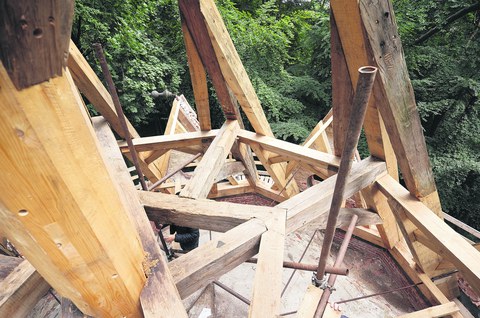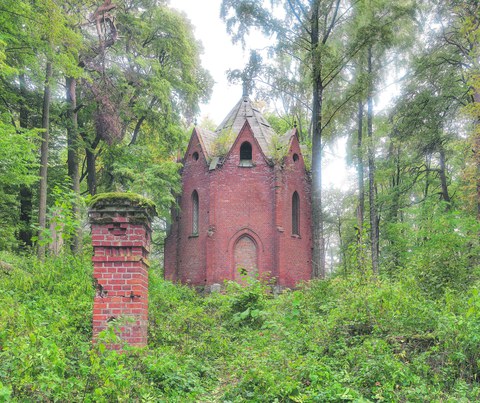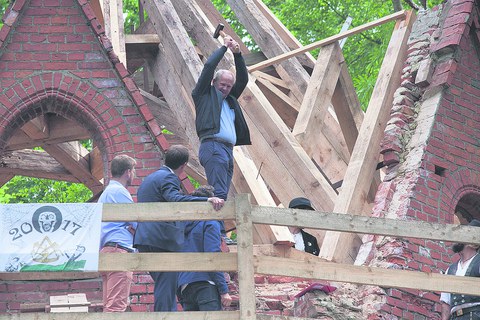Lehndorff cemetery chapel saved

Old and new beams make it possible to trace the building‘s history
The Chair of Structural Design and journeyman carpenters replace the roof frame of the neo-gothic mausoleum in Poland
Author: Anke Eis
On July 14, 2018, journeyman carpenters from the society of ‘Freie Vogtländer Deutschlands – Einheimische und reisende Bauhandwerker’ (Free Vogtlanders of Germany – Local and traveling construction workers) celebrated their renovation of the Lehndorff family’s cemetery chapel roof frame in the Polish village of Sztynort with a topping out ceremony. The neo-gothic mausoleum on the grounds of the Lehdorff family’s former estate with its manor house, farm and palace gardens was in a state of disrepair and had been left derelict. The chapel was designed by architect Friedrich August Stüler, a student of Karl Friedrich Schinkel and one of the most important architects of the Prussian royal house during the 19th century.
Prof. Wolfram Jäger, Senior Professor of Structural Design at TU Dresden’s Faculty of Architecture made the renovation of the decayed roof structure possible. Jäger, an internationally recognized expert for the restoration of historical buildings, initiated a fundraising campaign to save this remarkable structure. What’s more, the work itself was only viable thanks to a scaffolding solution of his own design. Owing to the projecting scaffolding, considerable costs could be saved and funds from the tight budget could be diverted largely to the roof and masonry construction.
Prof. Monika Grütters, the German Federal Government Commissioner for Culture and the Media, supported the initiative, as did the Deutsch- Polnische Stiftung Kulturpflege (German-Polish Foundation for Cultural Preservation) and the Lehndorff- Gesellschaft Steinort (The Lehndorff Steinort Society). Commercial industry also generously supported the project with donations of construction material, notably Wienerberger, Remmers, Xella, Tubag, Egger and the Hermann Graf von Hatzfeldt Wildenburg’sche Management. Young employees from the Chair of Structural Design and Jäger Ingenieure GmbH took on planning preparations on a voluntary basis and architect Mikolaj Nowakowski secured the necessary permits. Matthias Hohl, as a local building contractor, offered assistance during dismantling and raising work with machines and devices, as well as with his employees. He also made sure that the cross, standing almost two-meters tall, again crowns the chapel. Only fragments had survived, and these served as the model for a replacement, which the Lehndorff Society made possible yet again by means of a fundraising campaign. Thanks also go to the town of Węgorzewo, which, at its own cost, repaired the road through swampy terrain for the topping out ceremony and the subsequent work on the chapel.

The derelict Lehndorff cemetery chapel before work began
Junior engineer Paul Neumann from Jäger Ingenieuren GmbH, who had himself spent three years as a journeyman, acted as supervisor. He prepared and led the framing calculations. Neumann deserves every respect, as the joints ultimately fit down to the millimeter. He also used as much old wood as possible, thus meeting the highest standards of historic preservation. The high point was when the central post was replaced, which weighed almost 600 kilograms and supported the 300 kilogram cast iron dome and cross. The preparations were a particular challenge due to the knowledge and skills called for to preserve the geometric design of the building.
Comprehensive teaching materials based on the project and its execution will help future architecture students to undertake comparable tasks in the renovation of historical buildings. Raising the roof structure sheer muscle power and a return to the basic rules of mechanics. For a start, a crane could never have made it to the site through the swampy area, and secondly, the considerable distance it would have had to travel would have been costly. The raising took longer as a result, but was less expensive.
Around 100 guests came to attend the topping out ceremony and celebrate the first milestone in rescuing this architectural gem. They included the owners, the Deutsch- Polnische Stiftung Kulturpflege (German-Polish Foundation for Cultural Preservation), represented by the German Honorary Consul from Olsztyn, Wojciech Wrzecionkowski, the Deputy Mayor of Węgorzewo, Andrzej Lachowicz, with representatives of the town and Senator Wieslaw Pietrzak. Journeyman Malte Urban held the address and Wojciech Wrzecionkowski, as a representative of the owners, drove in the last rafter nail. This was followed by greeting addresses from the Consul General, Cornelia Pieper, the Chair of the Lehndorff Society, Dr. Bettina Bouresh, and the Head of the Saxony Staatskapelle Dresden, Christian Thielemann. Wojciech Wrzecionkowski thanked the participants and supporters for their efforts and Andrzej Lachowicz underlined the importance of the restoration work for tourism and promised further support. Pastor Krystian Borkowski spoke the blessing at the conclusion.
After the carpenters had drained a boot of beer, they made their way by boat or on foot back to the palace, where the event was celebrated according to tradition with grilled sausages and beer until evening. The rescue of the Lehndorff Chapel is an achievement for civic engagement and thereby a sign of future success in the rescue and renovation of Steinort Palace itself.

July 14, 2018 topping out ceremony celebrating the renovated roof frame
This article was published in the Dresdner Universitätsjournal 13/2018 on September 4, 2018. You can download the whole newspaper as a PDF file for free here. Please contact doreen.liesch@tu-dresden.de to order the Universitätsjournal as a printed newpaper or as a PDF file. For more information, please visit: universitaetsjournal.de.
